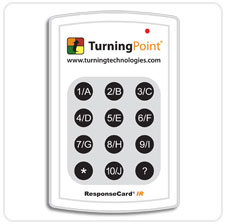With many college classes overflowing with students, large universities are turning to clickers to help professors keep track of their students and help organizations run meetings more efficiently. According to a recent article in the Chronicle of Higher Education more than 1,000 colleges use the handheld devices produced by Turning Technologies, which resemble a television remote.
Students register their name to the clickers and usually rent them out on a semester basis. The clickers are enabled with software that can display responses to questions in the form of charts at the front of the classroom and quickly assess student comprehension.
Professors with large lecture classes use the devices to answer multiple choice questions in class, but have faced issues with cheating. In one case, a professor at University of Colorado at Boulder caught one of his students in possession of four clickers during an exam. The student’s roommates had given him their handheld devices so they would be accounted for and have the test taken for them. Other professors, such as Matthew Hamilton from Georgetown University, have curved the use of the devices to count for only a small percentage of the grade in what he refers to as a “5 percent minimum”.
Student organizations are also using clickers to take attendance at meetings. Louisiana State University spent more than $2,000 when they installed clickers at all 75 Senate seats for their Student Government. Speaker of the Senate Aaron Caffarel said the clickers would be used to see how student representatives voted on referenda.
These clickers provide more transparency in student-professor interactions and organizational meetings. But like most classroom technology, they are only useful when they can enhance the learning experience rather than give students incentive to find their way around assignments.






